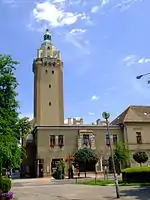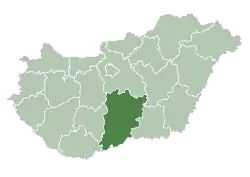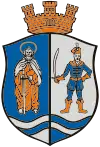Kiskunhalas
Kiskunhalas (German: Hallasch) is a city in the county of Bács-Kiskun, Hungary.
Kiskunhalas | |
|---|---|
.jpg.webp) The Tower of the Town Hall | |
 Flag  Coat of arms | |
 Kiskunhalas Location of Kiskunhalas  Kiskunhalas Kiskunhalas (Europe) | |
| Coordinates: 46.43201°N 19.48850°E | |
| Country | |
| County | Bács-Kiskun |
| District | Kiskunhalas |
| Area | |
| • Total | 227.58 km2 (87.87 sq mi) |
| Population (2009) | |
| • Total | 28,997 |
| • Density | 128.16/km2 (331.9/sq mi) |
| Time zone | UTC+1 (CET) |
| • Summer (DST) | UTC+2 (CEST) |
| Postal code | 6400 |
| Area code | (+36) 77 |
| Website | www |
Railroad
The city is an important railway junction. It crosses the Budapest-Subotica-Belgrade railway line. The Kiskunfélegyháza railway ends in Kiskunhalas.
Geography
Kiskunhalas is located 130 km (81 mi) south of Budapest.
Name
Kiskunhalas used to be surrounded by lakes that were rich in fish, Halas in Hungarian, and this gave rise to the town's name. The other part of the name comes from the Hungarian kiskun-, meaning Little Cumania (Hungarian: Kiskunság); Kun was what the Hungarians called the Cuman people.
Croats in Hungary call this town as Olaš.[1] The Croat name came as shortening of its Hungarian name, as it was easier for Croat speakers to pronounce it that way.
History
Its known history goes back to the 9th century. Kiskunhalas has many archaeological artifacts. These are displayed in the János Thorma Museum, established in honor of an early 20th-century painter who was born and grew up here.
Several villages were known to have been in the area from 895. The place became significant when the Cumans arrived. Its name is derived from the Hungarian word, Kun, for the Cumans. The first written documents mentioning Halas date to 1347.
After 1596, the town lost much of its population due to warfare during the Ottoman invasion and plague.
In the 16th and 17th centuries, Kiskunhalas welcomed the Protestant Reformation. Until 1754 the city was the center of the region, but after that, its significance declined under Catholic rulers because of the local people's support for Protestantism. A Roman Catholic church was built in 1770. A new Reformed (now called Presbyterian) church was built in 1823.
In 1910 the population reached 25,000.
Gallery
Notable natives and residents
- János Thorma (1870-1937), a painter and founding member of the influential Nagybanya artists' colony, was born and grew up here.
- Zsolt Daczi (1969–2007), hard-rock guitarist, was born here.
- Erika Miklósa
Sports
The town is the birthplace of the highest ranked Hungarian tennis player Ágnes Szávay (at one time ranked 13th in the world), who has won five WTA titles.
International relations
Twin towns – Sister cities
Kiskunhalas is twinned with:
|
|
See also
References
- "Folia onomastica croatica 14/2005" (in Croatian). (462 KB) Živko Mandić: Hrvatska imena naseljenih mjesta u Madžarskoj,
- "Aizkraukles novada sadarbības pilsētas". Archived from the original on 19 July 2017. Retrieved 4 July 2017.
- "Miasta partnerskie i zaprzyjaźnione Nowego Sącza". Urząd Miasta Nowego Sącza (in Polish). Archived from the original on 23 May 2013. Retrieved 1 August 2013.

.jpg.webp)
_2.jpg.webp)
_3.jpg.webp)






